 |

Botanical Society of the British Isles
Field Meeting in the Sierra de Grazalema
led by Teresa Farino and Jon Cox
20 - 27 April 2007
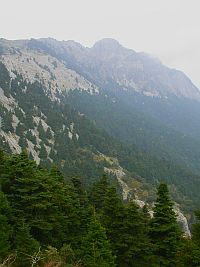 El Pinsapar© Teresa Farino El Pinsapar© Teresa Farino
Twelve BSBI members spent a very enjoyable week exploring the Grazalema Natural Park and surrounding area in Andalucía. Despite - or maybe because of - the occasional rain, we found the flora of the area to be extremely diverse, incorporating a large number of Afro-Iberian elements, and many species unique to southern Spain.
20 April - Churriana
Members of the group arrived at Málaga Airport during the course of the morning, and once all were assembled, we were keen to get away from the city and find somewhere to have a late lunch. We had only travelled a short distance to the outskirts of the city when a suitable area of open ground was spotted at a location known as Churriana. While some of us gave in to appetite and started lunch, others were motivated to begin botanising straight away.
The site could be broadly called garrigue, but was somewhat disturbed by its 'urban-fringe' location. What was immediately impressive was the scattering of sizeable Olive trees (Olea europaea) in full flower. Everyone said they had never seen Olives in the flowering condition before, or at least not as profusely as the specimens before us. Among the low-growing clumps of Chamaerops humilis (Dwarf Fan Palm), the strongly aromatic Thymus capitatus and more faintly scented Lavandula multifida (Cut-leaved Lavender) were patches of the very conspicuous orange-yellow flowers of the composite Cladanthus arabicus (Cladanthus), along with scattered Chrysanthemum coronarium (Crown Daisy), and stands of the lemon-yellow-flowered labiate Phlomis lychnitis and Asphodelus fistulosus (Hollow-stemmed Asphodel).
 Phlomis lychnitis© Teresa Farino Phlomis lychnitis© Teresa Farino
Grasses were also a very conspicuous element of the vegetation and included the attractive Lagurus ovatus (Hare's-tail) and Lamarckia aurea (Golden dog's-tail), along with the less obvious Cynodon dactylon (Bermuda-grass). In total, Arthur Copping noted 15 members of the Gramineae here, the others being Stipa capensis (Mediterranean needle-grass), Trachynia distachya, Anisantha diandra (Great Brome), A. madritensis (Compact Brome), Bromus hordeaceus (Soft-brome), Polypogon monspeliensis (Annual Beard-grass), Oryzopsis miliacea (Smilo-grass), Aegilops sp. (probably A. geniculata), Hordeum murinum (Wall Barley; probably ssp. leporinum), Rostraria cristata (Mediterranean hair-grass), Avena barbata (Slender Oat) and Hyparrhenia hirta.
Clovers and plantains were also well-represented, with Trifolium stellatum (Starry Clover), T. tomentosum (Woolly Trefoil), T. angustifolium (Narrow-leaved Crimson Clover), Plantago afra (Glandular Plantain) and P. lagopus being seen. A diverse array of other eye-catching plants was noted amongst the sward, including Silene colorata, Paronychia argentea, Emex spinosa (Emex), Oxalis pes-caprae (Bermuda-buttercup), Lobularia maritima (Sweet Alison), Tripodion tetraphyllum (=Anthyllis tetraphylla) (Bladder Vetch), Lathyrus cicera, Bituminaria (Psoralea) bituminosa (Pitch Trefoil), Erodium malacoides (Soft Stork's-bill), Lavatera cretica (Small Tree Mallow, considered Vulnerable in the UK), Teucrium pseudochamaepitys (Ground-pine Germander),
T. polium (Felty Germander), Cynoglossum creticum (Blue Hound's-tongue), Bellardia trixago (Bellardia), Cuscuta epithymum (Dodder), Convolvulus althaeoides (Mallow-leaved Bindweed), Pallenis spinosa, Galactites tomentosa (Galactites), Silybum marianum (Milk Thistle), Allium roseum (Rosy Garlic) and Colchicum lusitanum (in fruit).
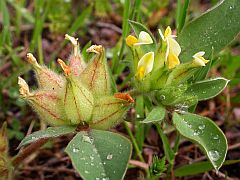 Bladder Vetch
Bladder Vetch
Tripodion tetraphyllum
© Teresa Farino
With everyone suitably refreshed, we set off on the journey to Grazalema, with a bit of plant spotting from the minibuses en route. Species seen included Spartium junceum (Spanish Broom), Genista hirsuta, Ricinus communis (Caster-oil-plant), Cistus ladanifer (Gum Cistus), C. populifolius (Poplar-leaved Cistus) and the naturalised Arundo donax (Giant Reed). Not far from Grazalema itself we stopped beside the road where another brief bout of botanising ensued, this time producing Mercurialis tomentosa, Anagyris foetida (Bean Trefoil), Stachys ocymastrum, Centaurea pullata, C. calcitrapa (Red Star-thistle, very rare in the UK), Muscari comosum (Tassel Hyacinth), Ornithogalum narbonense, Gynandriris sisyrinchium (Barbary-nut) and Ophrys lutea (Yellow Ophrys).
21 April - Around Grazalema
Grazalema is a tightly packed pueblo blanco in the Parque Natural de la Sierra de Grazalema, lying on the eastern side of the highest peaks, which rise to 1,654 metres. The park mostly comprises well-eroded limestone, alternating with smaller areas of acidic rock. These mountains are only separated from the Atlantic by a low-lying coastal plain, such that moisture laden winds drop most of their precipitation here, giving Grazalema the dubious reputation of having the highest rainfall in Spain, with around 2,230 mm per annum. Some of this rain fell on our first day, but with such interesting plants to see and with umbrellas up, we hardly noticed the dampness. Even before we had left the village, we had seen Sedum mucizonia, Centranthus macrosiphon and Veronica cymbalaria (Cymbalaria-leaved Speedwell) growing in cracks in the walls around the market-place viewpoint.
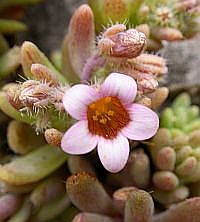 Sedum mucizonia
© Teresa Farino
Sedum mucizonia
© Teresa Farino
Grazalema is perched on a high cliff and the old road winds round to the base of this. Our route out of the village led us past vegetable plots and sheds containing chickens, and so on to this ancient cobbled route. Here we found our first Scandix pecten-veneris (Shepherd's-needle) in profusion: a species that we saw on all subsequent days. We also saw Saxifraga granulata (Meadow Saxifrage) growing in pockets of soil in the rocks and looking slightly different from our British plants. Other attractive species seen were the deep-yellow toadflax Linaria platycalyx, which is unique to the Serranía de Ronda, the bright-pink-flowered Antirrhinum majus (Snapdragon), which most members initially thought to be a garden escape, and the Afro-Iberian endemic Scrophularia sambucifolia (Elder-leaved Figwort), with large, orange-red flowers.
The rocks and walls edging the path provided comfortable eye-level botanising. Ferns taking advantage of the shelter in the crevices included Cheilanthes acrostica, Polypodium cambricum (Southern Polypody) and Anogramma leptophylla (Jersey Fern). Other highlights, as we made our slow way down, included the little mauve Arabis verna (Spring Rock-cress), Vinca difformis (Intermediate Periwinkle), Geranium purpureum (Little-Robin), G. rotundifolium (Round-leaved Crane's-bill), Eryngium campestre (Field Eryngo), Campanula erinus (Annual Bellflower), Delphinium staphysagria (Licebane) and the controversial Hyacinthoides hispanica (Spanish Bluebell).
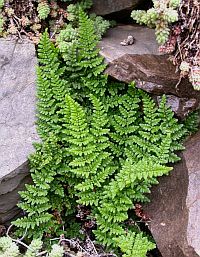 Cheilanthes acrostica
© Teresa Farino
Cheilanthes acrostica
© Teresa Farino
The loose rocks near the bottom of the cliff provide a habitat for Clematis flammula (the autumn-flowering Fragrant Clematis), Euphorbia characias (Mediterranean Spurge), the broom-like Osyris alba (Osyris) and Phlomis purpurea. The more agile members of our party were able to scramble up a little to find Hesperis laciniata (Cut-leaved Dame's-violet) and three Afro-Iberian endemics: the frothy yellow masses of flowers of Biscutella frutescens, the purple-flowered birthwort Aristolochia baetica and the red-berried mistletoe Viscum cruciatum, here growing on Ivy (Hedera sp.).
Overhead, Crag Martins and Choughs were wheeling and calling. Lower down we found little Fedia cornucopiae (Fedia) and Parentucellia latifolia (Southern Red Bartsia), both deep-red flowered. Grasses seen on the way down included Poa infirma (Early Meadow-grass), P. bulbosa (Bulbous Meadow-grass), Cynosurus echinatus (Rough Dog's-tail) and Melica minuta.
We enjoyed lunch at the base of the cliffs, listening to Nightingales and watching Rock Thrushes and Black Wheatears flitting around the crags. Competing for our attention with the delicious food were such botanical delights as the yellow-flowered Spanish endemic knapweed Centaurea clementei, the Afro-Iberian endemic labiates Ballota hirsuta and Stachys circinata, and the unmistakeable composites Rhagadiolus stellatus (Star Hawkbit) and Hyoseris radiata. Here too we found more Ophrys lutea, and also O. tenthredinifera (Sawfly Ophrys).
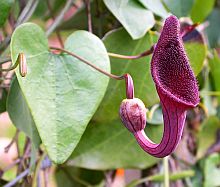 Aristolochia baetica
© Teresa Farino
Aristolochia baetica
© Teresa Farino
In the afternoon we climbed up to a small reservoir above the village. The soil here was rather more acid and amid the bushes of Bupleurum fruticosum (Shrubby Hare's-ear) we encountered a number of Afro-Iberian endemics: the yellow-flowered leguminous shrub Retama sphaerocarpa (Lygos), the tall-but-delicate white-flowered crucifer Crambe filiformis, Linaria tristis, a toadflax with brownish flowers, and the fern Pleurosorus hispanicus, distinctively covered with hairs, the latter the highlight of the week for John Edgington.
Other plants discovered along the way were three species unique to southern Spain: the gorse Ulex baeticus, whose specific name derives from the Arabic word for this part of Spain, the beautiful Echium albicans, and Ptilostemon hispanicus: one of the many spiny composites we would see during the week. The rocks around the reservoir itself turned up a compact clump of the Afro-Iberian endemic saxifrage Saxifraga globulifera, while in the surrounding pinewoods, amid an understorey of Cistus crispus and Lavandula stoechas (French Lavender), John found a few plants of Tulipa sylvestris ssp. australis (Wild Tulip), Louise encountered the sand-crocus Romulea bulbocodium, and Caroline spotted both Orchis (Anacamptis) morio (Green-winged Orchid) and Cephalanthera longifolia (Sword-leaved Helleborine).
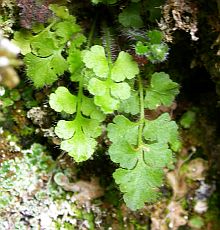 Pleurosorus hispanicus
© Teresa Farino
Pleurosorus hispanicus
© Teresa Farino
As a complete contrast to the rockgardens of the morning, our route back to Grazalema passed a wet, peaty hollow containing a number of species considered Vulnerable in the UK - Mentha pulegium (Pennyroyal), Scirpoides holoschoenus (Round-headed Club-rush) and Carex divisa (Divided Sedge) - plus Oenanthe globulosa (Mediterranean Water-dropwort), the woolly-leaved St John's-wort Hypericum tomentosum, and Molineriella minuta ssp. australis: a delightful grass similar to Aira. This rather damp, soggy habitat summed up the day for us really: 'wet but very interesting'!
22 April - Embalse de Bornos & Lagunas de Espera
After that rainy first day around Grazalema we decided to go in search of some sunshine in the lowlands to the west. First we had to take a winding road over the rugged limestone sierra and descend through woodland, where the fresh unfolding leaves of Quercus faginea (Lusitanian Oak) enlivened the sombre greens of Q. ilex ssp. ballota (Western Holm Oak), and further splashes of colour were provided by the pink-flowered Cistus albidus (Grey-leaved Cistus) and yellow Ulex baeticus ssp. baeticus.
 Slender Salsify
Slender Salsify
Tragopogon hybridus
© Teresa Farino
What was meant to be a brief stop at the tail-end of the Embalse de Bornos (reservoir) turned into an hour's botanising in fields that were formerly flooded, now dry through water abstraction. The grasslands were yellow with Ranunculus trilobus (Three-lobed Buttercup) and R. muricatus (Rough-fruited Buttercup), and it was good to see a large patch of Silene gallicus (Small-flowered Catchfly), in view of its major decline in Britain. Many of the species here were those seen at Churriana, but among the more notable additions were Anchusa azurea (Large Blue Alkanet), Convolvulus meonanthus, with delicate blue flowers, Tragopogon hybridus (Slender Salsify) and Notobasis syriaca (Syrian Thistle). European Bee-eaters hawked overhead, Cattle Egrets flounced through the fields after grasshoppers and a Woodchat Shrike perched obligingly on a notice board.
Our main destination for the day was the Lagunas de Espera, a nature reserve with three lagoons which have no outlets and are therefore brackish, due to evaporation. A roadside stop overlooking the reserve enabled a comparison of three blue-flowered pimpernels: Anagallis arvensis ssp. arvensis (Scarlet Pimpernel, although often blue-flowered in this region), A. foemina (= A. arvensis ssp. caerulea) (Blue Pimpernel) and the handsome perennial A. monelli (Shrubby Pimpernel). Here too we encountered Centranthus calcitrapae (Annual Valerian), Asteriscus aquaticus, Arum italicum (Italian Lords-and Ladies), Serapias parviflora (Small-flowered Serapias) and Ophrys bombyliflora (Bumble-bee Ophrys).
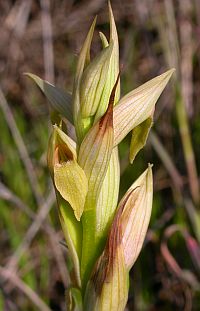 Small-flowered Serapias
Small-flowered Serapias
Serapias parviflora
© Teresa Farino
Beside the tracks through the reserve, the plants that caught our eyes - other than the dazzling stands of Echium plantagineum
(Purple Viper's-bugloss) - were Lythrum hyssopifolia (Grass-poly; a protected plant in Britain) and L. junceum (False Grass-poly),
Bellardia trixago and the more familiar Parentucellia viscosa (Yellow Bartsia), as well as the pheasant's-eye Adonis microcarpa ssp.
microcarpa, much Ecballium elaterium (Squirting Cucumber) and mats of two pinkish-purple flowered vetches: Astragalus echinatus and
Hedysarum glomeratum. Here too was Chamaerops humilis in flower, as well as two birthworts - Aristolochia baetica and A. paucinervis
- and a striking, almost orchid-like broomrape, Orobanche crenata, parasitic on legumes. Ranunculus baudotii (Brackish Water-crowfoot),
a species of Frankenia (Sea Heath) and Spergularia marina (Lesser Sea-spurrey) were indicators of the saline conditions, while Arthur
Copping's discerning eye spotted Gaudinia fragilis (French Oat-grass), Avellinia michelii and Carex distans (Distant Sedge).
 Yellow Bartsia
Yellow Bartsia
Parentucellia viscosa
© Teresa Farino
The lagoons, fringed with reeds and willows, produced some notable birds: the globally threatened White-headed Duck, as well as Red-crested Pochard, Black-necked Grebe and Purple Gallinule, but diligent scanning failed to identify a Crested Coot among the many Common ones. The reedbed resounded with the guttural croaking song of Great Reed Warblers, and a Short-toed Eagle presented good views as it escorted an intruder from its territory.
23 April - La Rana & Benaocaz
La Rana is an area of unfenced damp pasture south-west of Grazalema on the road to Ubrique and, at the end of April, is usually the place to find a host of orchid species. With the lateness of the season and recent rains, however, there were rather more caramel-coloured, pork-sausage-sized Iberian Slugs (Lehmannia valentiana) than orchids. Nevertheless, amongst the lush green vegetation studded with early spring flowers, and to the constant accompaniment of an enthusiastic Cuckoo, we did manage to find some orchids not already seen: Serapias lingua (Tongue Orchid) and Ophrys fusca ssp. fusca and ssp. dyris, (Dull Ophrys).
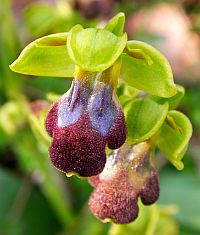 Dull Ophrys
Dull Ophrys
Ophrys fusca ssp. fusca
© Teresa Farino
On drier ground, there was the delicate Romulea bulbocodium and a few tardy blooms of the exquisite Narcissus papyraceus (Paper-white Daffodil), as well as the Afro-Iberian endemic Biscutella baetica, and the shrubby Daphne gnidium, whose berries are much favoured by warblers. On the reptile front, several Western Three-toed Skinks were seen wriggling through the longer grass, Jon spotted a rather hefty male Ocellated Lizard, with a characteristically robust head and the distinction of being the largest species of lizard in Europe, and Karl photographed a Spanish Psammodromus.
Heading down a few contour lines past Villaluenga del Rosario, through a magnificent towering gorge, spring was much more in evidence and the spot we chose to continue botanising was truly glorious. Sheets of lime-green Euphorbia draped the lower cliffs of the defile, and the roadside rockgardens were radiant with a profusion of bright flowers, including the stunning Scilla peruviana (Portuguese Squill), the intensely reddish-pink Lathyrus tingitanus (Tangier Pea) and Hyacinthoides hispanica, whose leaves seemed much narrower than the dimensions given in British floras.
We picnicked among several species of Ophrys, including O. speculum ssp. speculum (Mirror Ophrys),
O. bombyliflora and O. fusca ssp. bilunulata. Orchis species abounded too, including
O. langei and O. mascula (Lange's and Early Purple Orchid, respectively), the latter in a range of colours
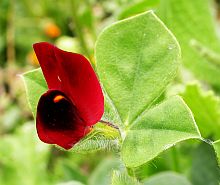 Asparagus Pea
Asparagus Pea
Tetragonolobus purpureus
© Teresa Farino
from pale pink to intense purple. A splendid, if less exquisite, Barlia robertiana (Giant Orchid) towered up over
the surrounding vegetation, while Anemone palmata (Palmate Anemone) and Tetragonolobus purpureus (Asparagus Pea)
were also recorded here.
Our first sighting of the lovely Afro-Iberian endemic Ornithogalum reverchonii, with its one-sided spike of white nodding bells, was thanks to Jane and Maurice, who had walked ahead and spotted it on the roadside. The ornithologists among us were rewarded with the sight and sounds of Blue Rock Thrush, Black-eared Wheatear, Melodious Warbler, Stonechat, Cirl and Rock Buntings and Rock Sparrow.
We finished off the day near the attractive village of Benaocaz where, after recording Cerinthe major (Honeywort) and Scrophularia canina (French Figwort), we made our way down another ancient paved mule track (which we shared with a party of noisy schoolchildren and a small herd of very cute black pigs), over a photogenic stone bridge to a lush meadow where, among a carpet of orchids, we at last found a single spike of Orchis laxiflora (Lax-flowered Orchid). The weather in Grazalema again lived up to its reputation by dumping several clouds' worth of heavy rain on us just as we were making our way back to the vehicles.
24 April - Sierra del Endrinal
Today was market day in the white village of Grazalema; a good opportunity to stock up on provisions for the excellent lunches to which we had now become accustomed. Teresa bought large boxes of strawberries and delicious loquats, the smooth, yellow, pear-shaped fruits of Eriobotrya japonica. Most of the other stalls were laden with cheap clothing where some of us found many-pocketed gilets: the perfect garment for botanising!
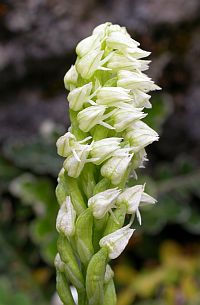 Dense-flowered Orchid
Dense-flowered Orchid
Neotinea maculata
© Teresa Farino
Our aim today was to explore the limestone hillsides and plateaux to the south of the village: the Sierra del Endrinal. We took the woodland path above the car-park and climbed up under pines and cypresses to the Monumento del Sagrado Corazón, at the base of which the villagers had placed their votive flowers. Not distracted by these garish bouquets, we found three saxifrages amongst the limestone rocks: Saxifraga granulata, S. globulifera, and S. tridactylites (Rue-leaved Saxifrage), the latter seemingly reluctant to display its 3-fingered leaves here.
Up here in bright sunlight we spotted a Spanish Swallowtail, a Spanish Festoon and a Small Copper, whilst Griffon Vultures soared above us and Bonelli's Warblers sang to us from the pines. In the shady margin of the path were several pale, creamy spikes of Neotinea maculata (Dense-flowered Orchid). As we reached the ruins of an old chapel - the Ermita del Calvario - a Large Psammodromus lizard was spotted on one of the sun-baked stone walls, and as we descended once more to the village, a small clump of Orchis italica (Naked Man Orchid) was encountered by the roadside.
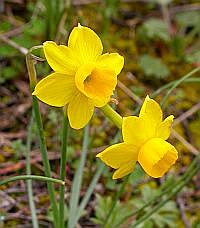 Narcissus assoanus ssp. praelongus
© Teresa Farino
Narcissus assoanus ssp. praelongus
© Teresa Farino
We lunched to the west of the village, at the Puerto del Boyar, where we enjoyed wonderful views to the south before
the rain started once more. Undeterred, we climbed up through the pine forest to the rocky Sierra del Endrinal, past Bellis sylvestris (Southern Daisy), Helleborus foetidus (Stinking Hellebore) and Iris foetidissima (Stinking Iris). As we approached the tall, fissured crags, we spotted the dainty bright yellow Narcissus assoanus ssp. praelongus (= N. requienii) (Rush-leaved Jonquil), Hornungia petraea (Hutchinsia) and, nestling in the crevices, our fourth Saxifrage of the day, the slightly sticky leaved, white-flowered Saxifraga bourgeana, endemic to the Serranía de Ronda and included in the Spanish Red List as Vulnerable. An investigation of the most sheltered hollows here also revealed some superb specimens of that curious Afro-Iberian endemic fern Pleurosorus hispanicus, here growing amid the characteristic umbrella-shaped fruiting bodies of Marchantia liverworts.
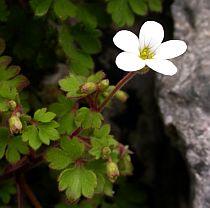 Saxifraga bourgeana
© Teresa Farino
Saxifraga bourgeana
© Teresa Farino
As we gained height, eventually reaching the Puerto de las Presillas at around 1,300m, we noticed the vegetation becoming sparser and more closely grazed by sheep and probably Spanish Ibex. Bushes of the prickly-leaved Quercus coccifera (Holly Oak) and Rhamnus alaternus (Mediterranean Buckthorn) were reduced to prostrate branches clinging to the rocks, whereas large cushions of Erinacea anthyllis (Hedgehog Broom) were furnished with extremely sharp spines to protect the young fresh leaves and newly opening lilac-blue flowers from browsers. Scattered amongst these bushes were a few plants of Asphodelus albus (White Asphodel) and Euphorbia characias which we supposed were poisonous to grazing mammals, and so had successfully survived.
25 April - Sierra del Pinar and the pinsapar
From a car park lined with Retama monosperma (White Broom), we set off on our longest walk of the week: 12 km to the village of Benamahoma across a limestone sierra. En route we traversed the pinsapar: a great stand of Abies pinsapo (Spanish Fir) on the north flank of Grazalema's highest peak, Torreón (1648 m). An Ice Age relict species confined to three sierras in Andalucía, Abies pinsapo flourishes here thanks to strict control of livestock and access, which is by permit only. A busload of noisy teenagers who overtook us soon after the start seemed unaware of this, though fortunately they were soon out of earshot, replaced by the pleasanter song of Crested Tit, Firecrest and Bonelli's Warbler among Pinus pinaster (Maritime Pine) and P. halepensis (Aleppo Pine).
The rush-like Aphyllanthes monspeliensis (Blue Aphyllanthes), evil-smelling Putoria calabrica (Putoria) and the attractive Lithodora fruticosa (Shrubby Gromwell) were accompanied by other species new to us such as Ranunculus gramineus (Grass-leaved Buttercup) and the Grazalema endemic Phlomis margaritae, not yet in flower.
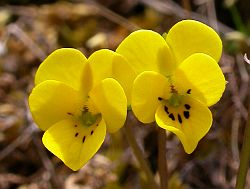 Viola demetria
© Teresa Farino
Viola demetria
© Teresa Farino
Two butterflies - Black-eyed Blue and Moroccan Orange-tip - appeared as the light rain ceased and we approached a col with a view of the pinsapar. Interesting plants of the limestone pavement here included a prostrate buckthorn Rhamnus saxatilis, and no fewer than seven Iberian and North African endemics: the crucifers Jonopsidium prolongoi and Brassica repanda ssp. confusa, Berberis hispanica, the charmingly diminutive Viola demetria, Saxifraga globulifera and Anarrhinum laxiflorum, as well as the handsome, yellow-flowered Draba hispanica ssp. hispanica, the latter spotted by eagle-eyed James after some of us had dismissed it as 'just another Alyssum'. Teresa pointed out Dactylorhiza insularis (Barton's Orchid), while a much-photographed rock stork's-bill was almost certainly Erodium recoderi: a species with an extremely localised distribution, being confined to the Grazalema park.
The daffodils too were of interest. In addition to the abundant Narcissus assoanus ssp. praelongus, we noticed plants with wider, glaucous, keeled leaves, which John has subsequently identified as the extremely local N. cuatrecasasii (= N. rupicola ssp. pedunculatus), first found at Grazalema by Stocken in the 1960s, and unique to southern Spain, as is the saxifrage - the fifth of the trip - Saxifraga haenseleri.
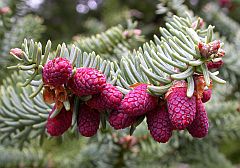 Spanish Fir
Spanish Fir
Abies pinsapo
© Teresa Farino
The party split after lunch, some returning to the starting point, others continuing the longer traverse to Benamahoma through the floristically rather dull Spanish Fir forest where the peonies Paeonia broteri (Western Peony) and P. coriacea were abundant but tantalisingly a week or two away from flowering. Two ferns, Asplenium onopteris (Irish Spleenwort) and Cystopteris fragilis (Brittle Bladder-fern), and later Selaginella denticulata (Mediterranean Selaginella), provided some compensation, as did the cherry-red female flowers of the Spanish Firs.
As we emerged into an open forest of Quercus faginea, many of these being giant pollards of great age, the flora became more varied. Arbutus unedo (Strawberry-tree), Pistachio lentiscus (Lentisc), Phillyrea latifolia and Teucrium fruticans (Tree Germander) grew in the understorey, while in areas recently cleared of scrub, Cephalanthera longifolia and C. rubra (Red Helleborine) were conspicuous, with Neotinea maculata somewhat more retiring. Herbs new to us included Geum sylvaticum and Arabis planisiliqua, with its tightly-appressed stem leaves, while brilliant splashes of orange and scarlet signalled the parasites Orobanche rapum-genistae (Greater Broomrape), and the curious little Cytinus ruber, respectively. Also here was the bizarre, evil-smelling fungus Clathrus ruber.
 Clathrus ruber
© Teresa Farino
Clathrus ruber
© Teresa Farino
We entered Benamahoma through a pasture rich in orchids, including Serapias parviflora, Aceras anthropophorum (Man Orchid) and half-a-dozen Ophrys species, including O. scolopax (Woodcock Ophrys), while the walls of a shady stream hosted Adiantum capillus-veneris (Maidenhair Fern) and Anogramma leptophylla, signalling the end to a long day, but an immensely satisfying one.
26 April - Cueva de la Pileta
Today we were lucky to have the chance of visiting this remarkable prehistoric cave. It was discovered in 1905 by a farmer, José Bullón, who descended a nearby pothole to collect bat guano for manure. To his amazement, he found himself in a vast chamber, with galleries leading to others, whose walls were covered with schematic paintings.
During the next hundred years, family members gradually explored the huge cave system, finding not only many
extraordinary geological formations, but also pottery, bones and a remarkable variety of cave paintings. Horses,
goats, reindeer and bulls are depicted, including a most realistic pregnant mare, as well as a monk seal and a
 Love-in-a-Mist
Love-in-a-Mist
Nigella damascena
© Teresa Farino
marine fish fully two metres long, indicating some past link with the sea. The diversity of cave paintings and
engravings, in black, red and yellow, show that the Pileta cave was occupied from the Palaeolithic era through to
the Bronze Age.
Pileta is one of the few remaining caves where one is permitted to visit the original, rather than a replica, and the number of visitors is strictly limited. It was altogether a magical experience to examine these relics of long-ago cultures, secreted in a labyrinth of narrow passages and spherical chambers, our way lighted only by small paraffin lanterns.
Back on a botanical note, on the rocks around the cave entrance we found a splendid specimen of Asplenium petrarchae,
as well as the white-flowered Omphalodes commutata, a plant whose world distribution is confined to the Serranía de
Ronda. Also here were Nigella damascena (Love-in-a-Mist), Calicotome villosa (Hairy Thorny Broom), the small-flowered
Astragalus epiglottis, Medicago orbicularis (Large Disc Medick), Jasminum fruticans (Wild Jasmine), Salvia viridis
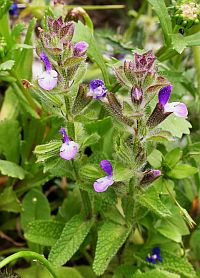 Annual Clary
Annual Clary
Salvia viridis
© Teresa Farino
(Annual Clary), the handsome Scorzonera hispanica, and Gladiolus communis ssp. byzantinus, while Arthur Copping pointed
out several grasses: Anisantha rubens (Foxtail Brome), Vulpia unilateralis and the annual Lolium rigidum (Mediterranean
Rye-grass).
27 April - Fuente de Piedra & the Torcal de Antequera
After sadly leaving the charming town of Grazalema we returned to Málaga via the extensive shallow saline lagoon of Fuente de Piedra. The shore vegetation was dominated by halophytes such as Suaeda vera (Shrubby Sea-blite), Frankenia pulverulenta and Parapholis incurva (Curved Hard-grass). Two members of the Boraginaceae were noteworthy: diminutive Neatostema apulum (Yellow Gromwell) and the almost black-flowered Nonea vesicaria.
It was, however, largely the birds that caught our attention: a huge colony of Greater Flamingos on an island far out
in the lake, and breeding Avocets, Black-winged Stilts and Kentish Plovers, together with many passage waders such as
Little Stint and Curlew Sandpiper, still en route to their breeding grounds in Arctic Siberia. Parties of Gull-billed
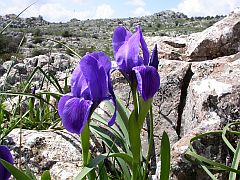 Iris lutescens ssp. subbiflora
© Teresa Farino
Terns and several Whiskered Terns hawked for insects over the saltmarsh and pools, while an elegant pratincole had all
the features of a Black-winged: an eastern species that shouldn't have been here.
Iris lutescens ssp. subbiflora
© Teresa Farino
Terns and several Whiskered Terns hawked for insects over the saltmarsh and pools, while an elegant pratincole had all
the features of a Black-winged: an eastern species that shouldn't have been here.
We drove on through Antequera and up onto the Torcal de Antequera, crowned by spectacular limestone formations. Here we had
the last of the memorable picnics which Teresa had magically managed to produce each day. We just had time for some
last-minute botanising, turning up a flowering clump of Paeonia broteri at last, Muscari neglectum (Grape-hyacinth),
Iris lutescens ssp. subbiflora, with deep violet flowers, and Barlia robertiana in full bloom. Growing together on a shady
rock, John and James encountered Ranunculus rupestris, exhibiting its large shiny yellow flowers, sprawling Linaria anticaria
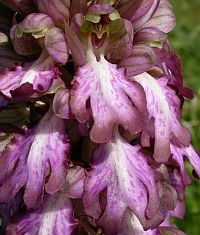 Giant Orchid
Giant Orchid
Barlia robertiana
© Teresa Farino
(originally described from here, and endemic to southern Spain) and much Saxifraga biternata (not yet in flower),
only found elsewhere on one nearby mountain. Several Rock Buntings and Blue Rock Thrushes used the rock pinnacles as
song-posts.
Having left most of the group at the airport, Teresa, Karl and Louise had time for one last foray into the nearby
Desembocadura del Guadalhorce, where the beach harboured Otanthus maritimus (Cottonweed) and Cakile maritima (Sea Rocket).
On the inland pools, we managed to get close-up views of Little Egret, White-headed Duck, a pair of Gadwall with two young,
Shoveler, Pochard, Dunlin, Little Ringed and Grey Plovers, and Common Sandpiper, with other birds feeding over the marshes
including Red-rumped Swallow, Fan-tailed Warbler, Bee-eater and Yellow Wagtail.
This report was written by the members of the party - Caroline Bateman, Joy and James Cadbury, Arthur Copping,
Jane and Maurice Croft, Karl Crowther, John Edgington, Louise Redgrave, Ann Sankey and Mary Clare Sheahan - and was
edited by Teresa Farino. It was previously published in BSBI News 106; 58-65 (September 2007).
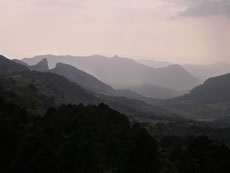 Looking south from the Puerto de Boyar
© Teresa Farino
Looking south from the Puerto de Boyar
© Teresa Farino
Botanical holidays in Spain and Portugal:
A Feast of Flowers - botanical holidays in the Picos de Europa
Sierra de Grazalema
Reports of other botanical trips in Spain and Portugal:
IWT Feast of Flowers in the Picos de Europa - Trip report 2009
BSBI Botanical Tour in the Castilian Páramos - Trip Report 2009
BSBI Botanical Tour in the Valle de Benasque - Trip Report 2008
BSBI Botanical Tour in Western Portugal - Trip Report 2006
BSBI Botanical Tour to the Catalan Pyrenees - Trip Report 2005
BSBI Botanical Tour of the Picos de Europa - Trip Report 2004
Related information:
Flora and fauna of Grazalema
Read about Teresa Farino
Botany holidays in Spain & Portugal
|